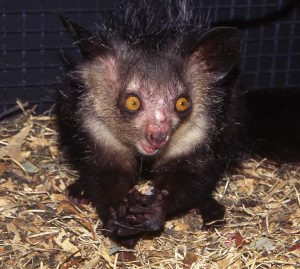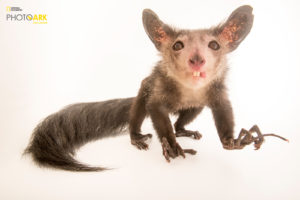By Rotsinomena Andriamisedra, EDGE Fellow 2020
Lemurs can be found nowhere else in the world.
Madagascar is the only country in the world where you can find lemurs of every shape and size. One of the lemur species active at night, and among the weird & wonderful EDGE species, is the Aye-aye (Daubentonia madagascariensis). It has big eyes which are necessary for their night vision, plus they can be used as an identifying feature when encountered by people or other animals at night. The body size of the aye-aye is around 580 mm to 1040 mm which is covered in black fur, along with having a fluffy tail. Like rodents they have teeth which perpetually grow. The main habitat of the aye-aye is in the coastal forests of Madagascar.
The Aye-aye is unique. Among the primates, it has a sixth digit which is called a pseudo thumb for gripping. During feeding time, it uses echolocation to knock on the trunk of the tree to know if there are insect larvae inside and then the aye-aye removes the bark with its teeth, in a scratching like motion, after which it scoops out the larvae by using its narrow middle finger.

The Aye-aye is endangered and on the IUCN red list due to hunting and habitat destruction caused largely by humans setting fires, illegal logging, making charcoal, as well as agriculture and livestock expansion. Unfortunately, this animal is also considered a messenger of evil and therefore killed on site when seen by local communities. In Madagascar, each region close to the Aye-aye’s habitat has their own beliefs of this marvelous animal. One area believes that if their middle finger points at someone, they are marked for death. In my site in the south east, when people from one village see the Aye-aye they kill it and move the body to the closest village and then it gets passed along to each village until it reaches the sea. They believe that the appearance of the animal will bring death to one of the members of their village and prevent the village from existing into future generations.
The local cultural belief of aye-aye’s being purveyors of evil has led directly to the decline in population of the Aye-aye. On top of this the local community has little access to food and very much depend on sourcing products from the forest, which in turn destroys the natural habitat of not only the Aye-aye but other fauna and flora. The lack of knowledge and education of the local community about conservation and the species that are local to them is a significant hurdle to conserving the species.
One of the most effective and basic ways to reach our conservation goal is by working specifically with children who are living on the edge of the forest. This will help us to better conserve this animal for future generations. Also, we will work with the local community to gather their knowledge about the species, while at the same time raising awareness for the most effective conservation actions. In addition, we will carry out research to increase the amount of information about the Aye-aye, from which we will be more likely to help with the conservation of this elusive animal.
